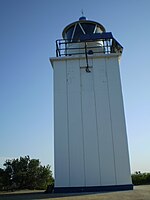Sydney Desalination Plant
The Sydney Desalination Plant also known as the Kurnell Desalination Plant is a potable drinking water desalination plant that forms part of the water supply system of Greater Metropolitan Sydney. The plant is located in the Kurnell industrial estate, in Southern Sydney in the Australian state of New South Wales. The plant uses reverse osmosis filtration membranes to remove salt from seawater and is powered using renewable energy, supplied to the national power grid from the Infigen Energy–owned Capital Wind Farm located at Bungendore. The Sydney Desalination Plant is owned by the Government of New South Wales. In 2012, the NSW Government entered into a 50–year lease with Sydney Desalination Plant Pty Ltd (SDP), a company jointly owned by the Ontario Teachers' Pension Plan Board (50%) and two funds managed by Hastings Funds Management Limited: Utilities Trust of Australia and The Infrastructure Fund (together 50%). The terms of the A$2.3 billion lease lock Sydney Water into a 50–year water supply agreement with SDP. The operator of the plant is Veolia Water Australia Pty Ltd. The Sydney Desalination Plant is the third major desalination plant built in Australia, after Kwinana in Perth which was completed in 2006 and Tugun on the Gold Coast which was completed in 2009.
Excerpt from the Wikipedia article Sydney Desalination Plant (License: CC BY-SA 3.0, Authors).Sydney Desalination Plant
Sir Joseph Banks Drive, Sydney Kurnell
Geographical coordinates (GPS) Address External links Nearby Places Show on map
Geographical coordinates (GPS)
| Latitude | Longitude |
|---|---|
| N -34.02475 ° | E 151.205136 ° |
Address
Sydney Desalination Plant
Sir Joseph Banks Drive
2231 Sydney, Kurnell
New South Wales, Australia
Open on Google Maps










